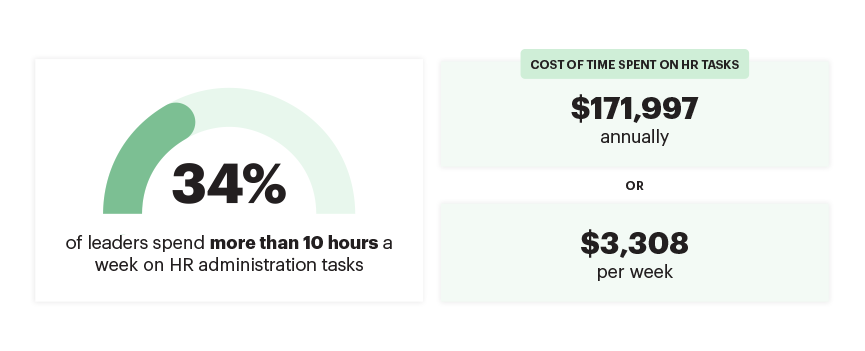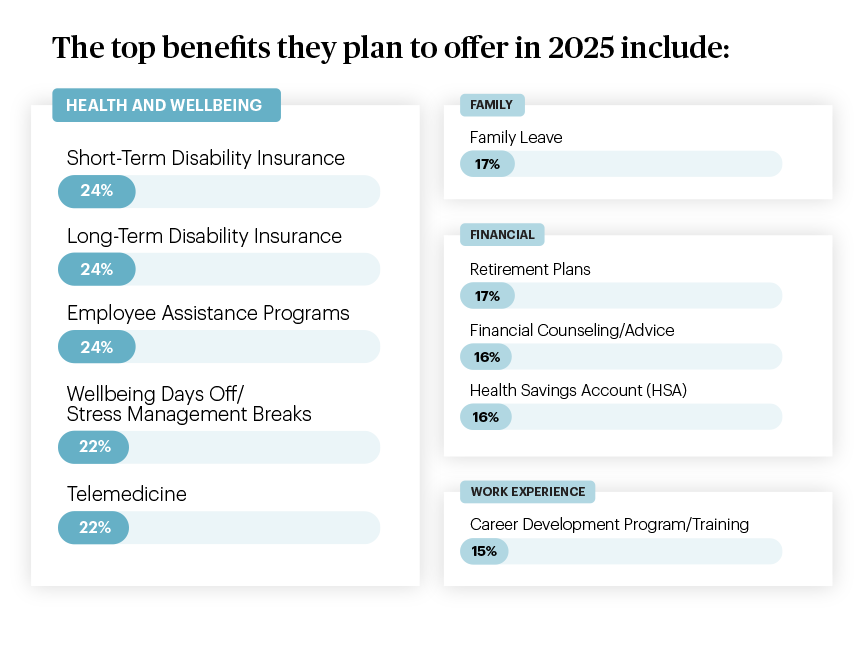- Human Resources
- 6 min. Read
- Last Updated: 12/19/2024
11 Hiring, Recruiting, and Talent Acquisition Trends on the Rise in 2025

Table of Contents
Finding and keeping talent remains a top priority for many business leaders. That's primarily due to lasting impacts on the professional landscape over the past few years: Many employees are continuing to reevaluate their priorities and values, emerging Gen Z workers are having an impact on reshaping hiring trends and prompting business owners to evaluate benefits and recruitment strategies, and economic uncertainties and a highly competitive talent market have created both challenges and opportunities for employers.
However, recruiting strategies will likely continue to dominate the conversation in 2025, with 50 percent of business leaders planning to hire more full-time employees and 85 percent expecting higher revenues over the next 12 months, according to Paychex's 2025 Priorities for Business Leaders study.
With so much at stake, let's review what latest hiring and talent acquisition trends have emerged and how leveraging them this year can help your business. Read on to learn more.
5 Recruiting and Talent Acquisition Trends in 2025
The future of talent acquisition and recruiting will likely center around speed, proactivity, and intentionality. Recruitment trends highlight the importance of actively searching for candidates for specific positions and developing a pool of candidates to be considered when specific jobs become available.
Businesses with proactive recruiters focus on contacting ready-now candidates to make their placements quicker and beat the competition. This typically requires building relationships, using all available channels to find and connect with potential new hires, making great first impressions, and building healthy and inclusive environments.
Take a look at the latest trends in talent acquisition and recruiting.
1. Providing More Efficient and Proactive Recruiting with HR Automation
Technology can be a great resource, from finding new employees to pushing out communications. While many businesses still struggle with finding great talent, there's a growing trend in recruiting to use HR automation and AI-assisted recruiting to help reduce costs and increase hiring efficiencies.
According to the 2025 Priorities for Business Leaders Survey, 34 percent of leaders spend more than 10 hours weekly on HR administrative tasks. Of course, as the business grows, these hours typically grow with it.

What makes this recruiting trend appealing is the level of integration across the hiring process and the faster overall process. Slow or poor communication from a talent acquisition team will not necessarily improve the candidate experience. This is where HR automation can help.
Some employers are speeding up the hiring process from end to end by:
- Using Paychex Recruiting Copilot to help find potential candidates faster.
- Leveraging recruiting technology such as automated screening forms to help vet candidates and streamline communication to keep them in the loop.
- Conducting interviews remotely to connect candidates and hiring managers who would otherwise experience delays and expenses associated with scheduling in-person interviews and coordinating travel.
Note that the use of HR automation in employment decisions is regulated by law in some jurisdictions. Employers are encouraged to audit their hiring practices including those using AI assistance to mitigate risk of potential bias, and other compliance concerns that may be regulated under federal, state and local laws.
2. Including Social Media as a Recruiting Channel
As businesses use social channels to grow their brands and generate leads, digital recruitment via social media may be an effective way to recruit talent.
Posting job opportunities and targeting social media platforms may be a successful way of recruiting talent that can be targeted to your industry and the skills you're looking for in a new hire.
With 57 percent of leaders surveyed indicating that attracting and retaining talent is a top priority for 2025, you can even narrow searches to target candidates actively seeking new employment opportunities. When your company uses modern recruitment tools like social media to build relationships with your target audience, you may be more likely to attract applicants, support a talent pipeline, and stay on top of hiring trends.
3. Focusing on the Candidate Experience
Adept businesses that focus on the employee experience know that a great experience starts from the first contact as a potential job candidate. It's a phase of the employee cycle that recruiting teams prioritize since this experience often sets the tone for subsequent interactions. Whether an individual joins the business or not, the trend of prioritizing the candidate experience allows businesses to gather valuable feedback on their applications, interviews, hiring teams, and the efficiency of the entire process.
All hiring managers should have the same approach when interviewing candidates for the same position to better ensure consistency across the board.
Paychex found that the top people management priority for the next 12 months are improving workforce productivity (95%), performance management (93%), and employee engagement and retention (90%).
4. Building and Using Referral Programs
Our fourth recruitment trend is about building and using referral programs. Strong employee referral programs can prove worthwhile for businesses that build and leverage them because finding great talent takes time and resources.
An employee referral program is a structured set of processes that allows current employees to recommend people they know to help fill open positions within their organization. Well-organized programs implemented consistently in conjunction with a company's overall hiring strategy can be integral to finding and maintaining a high-caliber workforce.
While referrals should not be the exclusive components of your hiring process, since they may lead to bias and a lack of diversity within a company, they can also create a win-win-win scenario:
- The business gets leads on job candidates for minimal recruiting costs
- The employee is incentivized (usually through a bonus or monetary reward) for recommending someone who's brought on board
- The job candidate gets a lead on an open position from someone connected to the organization
5. Creating Diverse and Inclusive Environments
Diverse and inclusive environments can deliver positive business benefits, and HR leaders often recognize this. For example, Paychex solutions empower businesses with actionable insights into their workforce analytics helping them identify areas where diversity and inclusion efforts may make the most meaningful impact.
6 Hiring Trends in 2025
Recent Paychex studies show that 98 percent of companies expect to use AI for hiring in the future. About 52 percent of respondents plan to use it to help them screen candidate resumes/applications and identify potential candidates.1
Knowing that finding great hires continues to be a challenge for many employers, these current hiring trends represent a broad range of approaches businesses can take to bring on and retain motivated, hard-working individuals.
1. Hiring for Soft Skills
Our first hiring trend is the importance of hiring for soft skills. For instance, soft skills such as problem-solving, collaboration, and leadership can be more challenging to find than hard skills that could be learned, like technical support or cashier processes.
A candidate's soft skills can significantly influence their ability to fit in with your culture. Identify some soft skills you want to bring into your organization, knowing you may be able to train a candidate in some of the hard skills required to execute on the job, such as learning your administrative processes and technology platforms.
2. Emphasizing Employer Branding, Company Values, and Workplace Culture
Employers may create a compelling, positive, and distinct candidate experience to recruit and hire the best talent and stand out from the competition. Employees may be looking to join a company aligned with their purpose and values and will help deliver meaning to their work. In addition, employees evaluate companies based on their employer brand:
- What they stand for
- How they treat and engage their employees
- Their company values
- Opportunities to gain experience and grow marketable skills
- Competitive compensation and benefits
3. Tapping into Internal Hires
Looking at your internal talent pools can help fill talent gaps by focusing on upskilling and reskilling current employees to meet changing and future business needs. Often, great candidates can be hidden in plain sight when recruitment efforts are focused outside of a company. Intelligent companies focus on their future by using internal recruiting as part of their strategic growth.
With 90 percent of business leaders concentrating on employee engagement, retention, and professional development in 2025, providing ongoing opportunities for career training and growth is potentially one of the best benefits your organization can offer employees. It shows your commitment to their career well-being. Today's employees seek opportunities to develop skills that have marketable value both within the future of their business and outside of their employment.
Help employees know what future skills are needed for success and provide opportunities to develop their skill sets and career paths to demonstrate your investment in their growth and development. This will also help you stay abreast of current and impending recruitment and hiring needs to inform your talent acquisition strategy.
4. Offering Valuable Employee Benefits
Gaining a competitive edge in talent acquisition and retention means that valued and meaningful benefits are now table stakes. According to the 2024 Priorities for Business Leaders survey, 46 percent of business leaders believe enhancing their benefit offerings is the most effective way to improve employee retention.
Health and retirement benefits and financial and mental health counseling services are great ways to support your employees' physical, emotional, and financial well-being. Rewards, recognition programs, and robust learning and development opportunities can also help employees feel more engaged with your company.
Consider conducting regular surveys to gauge which benefits are valued most by your employees to give your business a competitive edge.
5. Embracing Remote and Hybrid Work Models
According to the 2025 Priorities for Business Leaders Survey, 40 percent of employers have prioritized flexible work schedules.
As a result, the hiring of remote workers continues to emphasize digital hiring trends. Use modern recruiting techniques such as video interviewing, scanning social media channels, and other hiring practices that aren't limited by geographic proximity.
6. Providing Employee Wellness, Safety, and Support
Another significant hiring trend focuses on employee wellness, safety, and support. Fifty-two percent of employers surveyed by Paychex stated that employee mental health and wellness was a strategic challenge, just behind attracting and recruiting talent (57 percent).
Looking to 2025, 52 percent of leaders are prioritizing their support of employees' physical, financial, and mental well-being. Some top benefits employers may offer include:

Communicating to employees about how you will provide a safe and healthy work environment is critical to attracting great talent and maintaining a solid workforce. This includes building programs that address employee work/life balance, mental health, and support for remote workers.
Start 2025 on the Right Foot by Staying Ahead of the Trends
The beginning of the year is a great time to refocus on recruiting and hiring goals, including evaluating work environments, current processes, and other aspects of the employee life cycle. Consider recruiting and talent acquisition trends mentioned above, which may help you better align your goals and provide insights into innovative approaches to finding and bringing on great talent in 2025 and beyond.
Consider AI-assisted recruiting, hiring services and HR expertise from third-party providers to help you meet your talent recruiting goals.
1 2024 Priorities for Business Leaders, Paychex
Tags









